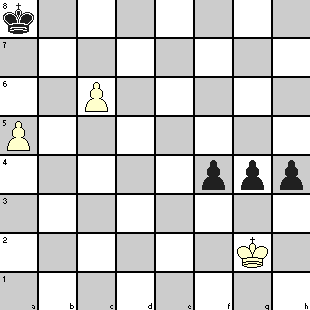Though I said ‘some’ but actually I meant one that goes under a German name and seems to have been in use in German chess literature since since early ninteenth century. It is supposed to have been introduced in English chess literature in early twentieth century by Emanuel Lasker, himself a German!
The word I have in mind is zugzwang. I understand that ‘zug’ means move and ‘zwang’ means ‘compulsion’, so the combined word means ‘compulsion to move’. Essentially, a player is said to be under zugzwang when any move that he makes will make his position worse and not to move would be the best move. But chess rules do not permit a player to skip move and the affected player under compulsion to move is committing a kind of ‘suicide’ by his move! Are you getting my point now? Suicide goes against the laws in most countries of the world and forcing another man to commit it is still more heinous! Shouldn’t therefore be a law against zugzwang (and wouldn’t the victims agree)?
Enough of chatter, can we see some example you will say. Though this is a potent weapon in chess endgames, it can occur at any time.
We first see an endgame problem that, though a very simple one, teaches you what zugzwang is and was created by French composer Henri Rinck (1870-1952) who was arguably the World’s Greatest Composer of chess problems.

White has to play and win in the position shown. The moves are:
| 1. | Rc7+ | Rd7 | ||
| 2. | Qc5+ | Kd8 | 2. … Ke6 3. Qf5+ loses the Rook | |
| 3. | Kh6 |
Black has the move and he is in zugzwang as any move makes him lose. Let us see what some of his options are:
King moves:
3. … Ke8 4. Qe5+ Kf7 5. Rxd7+ Kf8 (or Kg8) 6. Qxb8#
Rook moves:
3. … Rxc7 4. Qf8+ Kd7 5. Qxb8 wins.
If Black’s Rook leaves his second rank without any check, White will play 4. Qe7#
Queen moves:
3. … Qxc7 4. Qf8#.
Black Queen cannot deliver any viable check and trying to remain in contact with c8 square only enables its capture by White. If it loses contact with c8 square, White plays 4. Rc8#.
There are many other options available to Black and we have left it to you to find how the correct move (very important) by White in all the situations result in his winning the Black Rook or Queen or both, or delivering checkmate to the King.
You will notice that putting opponent in zugzwang is preceded by an idle (sometimes blocking) move by the attacker that forces the defender’s hand. In above example, 3. Kh6 was such a move.
Now that you have seen a simple one, here is another problem which is slightly more complex. This is a very old problem but quite instructive as similar position may arise in one of your endgames also. White is to play and win.

With two isolated pawns against three connected pawns, White may appear to be at a disadvantage but White’s winning line is as follows:
| 1. | a6 | Kb8 | Black King had to move to prevent 2. c7 |
|
| 2. | Kg1 | f3 | The idle move Kg1 to wait and watch is the only move that wins for White by creating zugzwang on Black |
|
| 3. | Kf2 | White’s strategy is simple: move the King to face whichever Black Pawn has advanced. Once that Pawn gets blocked, Black has to move another Pawn. In the meanwhile, Black King cannot move either way without allowing the other White Pawn to promote! You may try with other Pawn moves to verify the tactics. | ||
| 3. | … | h3 | ||
| 4. | Kg3 | h2 | ||
| 5. | Kxh2 | f2 | ||
| 6. | Kg2 | g3 | ||
| 7. | Kf1 | |||
| 7. | … | g2+ | ||
| 8. | Kxf2 | g1=Q+ | ||
| 9. | Kxg1 | Kc7 | With no more pawn to move, Black King is forced to take the move it was trying to avoid. | |
| 10. | a7 | Kxc6 | ||
| 11. | a8=Q+ | White wins. |
Because of its unusual nature, it is a popular theme for chess compositions and Susan Polgar’s blog of July 1 has a problem on this topic.
In Chess Tactics: Some more applications of Zugzwang, you will see a third problem and a game where this tactics was used.


2 Comments
Although suicide is against the law in most countries, one must consider that chess is a war being played out on 64 squares. In war, soldiers have been known to make sacrifices for other men or for the unit in order to win .
if the game was more in line with a social setting, than your point on suicide would be valid enough to consider.
@Robert
All that was in a lighter vein! If people start taking it seriously or putting more meaning than was intended, then I’ll have to start writing in a way people can read with a straight face!
Your point is taken, but still there is a logical anomaly in the analogy you brought. A soldier makes a sacrifice to achieve a higher goal. No one forces him into it, he does it on his own inspiration and hence a sacrifice is not considered a suicide! Suicide is condemned, sacrifice never!
Trackbacks/Pingbacks